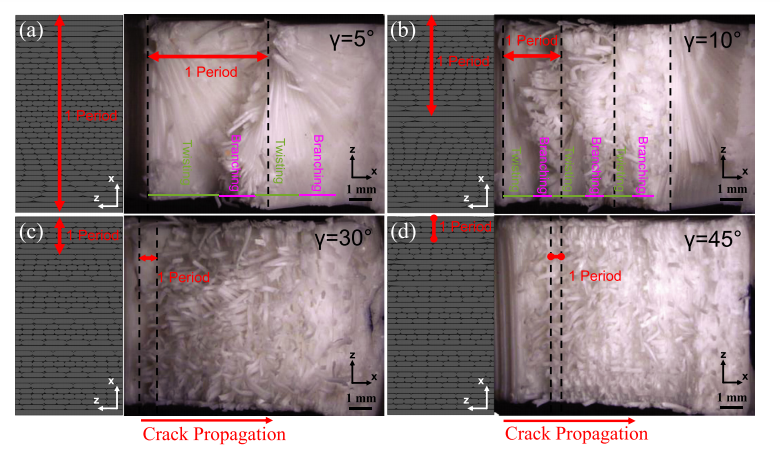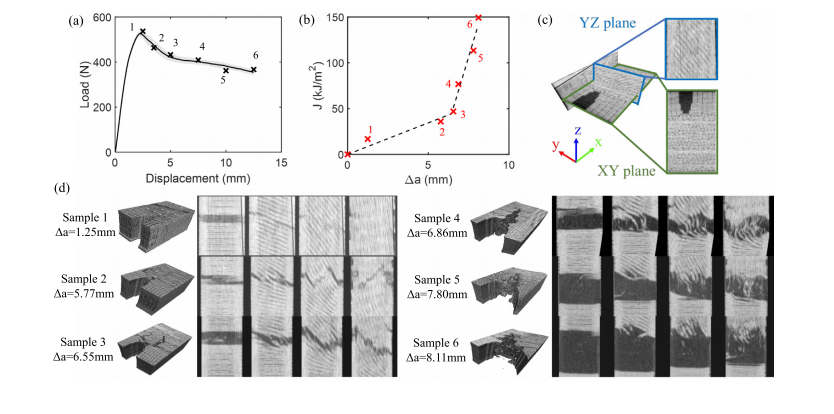Chengyang Mo and Jordan R. Raney, of the Department of Mechanical Engineering and Applied Mechanics, University of Pennsylvania, explore the role of defects in mechanical properties in the recently published ‘Spatial programming of defect distributions to enhance material failure characteristics.’
In this study, the researchers are embracing and studying defects rather than avoiding them—as well as working to improve and control them. Defects in ‘classical metallurgy’ may ultimately result in ‘order of magnitude changes,’ for mechanical properties, while in metal 3D printing defects like grain boundaries may increase strength as the propagation of dislocation is stalled.
“However, the importance of defects is much more general in materials engineering,” state the researchers. “For example, defects are also vital in natural materials, where voids and imperfect interfaces are responsible for producing excellent combinations of mechanical properties such as stiffness, strength, and toughness in materials that are also lightweight.”
Nature often offers inspiration too, as in the example of nacre, a laminate structure found in marine shell animals—offering a combination of both hard and soft material with ‘imperfect interfaces.’ In 3D printing, the study of layers and the use of multiple materials has let to a wide range of studies focused on defects and how they are caused.
“With multimaterial 3D printing it is possible to enhance the toughness of material by arranging soft and stiff phases in architectures that mimic natural motifs, such as that of conch shell, nacre, and Stomatopod dactyl club,” explain the researchers. “Bioinspired composites such as glass fiber-reinforced polymers, alumina-reinforced polymers, and epoxy-carbon fiber have also been developed for direct write 3D printing processes.”
As failure occurs, defects may guide the process, altering one area while enhancing another. These occurrences cannot be ignored as they offer insight into ways to refine 3D printing and additive manufacturing processes.
“Since it is the defects rather than specific material pairings that produce the desired properties the findings of this work are relevant to a broad swathe of additive manufacturing processes (FDM, DIW, SLS, etc.) and materials (polymers, metals, ceramics, and composites),” explain the researchers.
The researchers 3D printed single-edge notched bend (SENB) samples, demonstrating the impacts of defects on failure properties. They focused on the use of PLA due to the ‘very high failure strain of the PDMS.’

(a) Illustration of an extrusion-based additive manufacturing process with its characteristic systematic distribution of defects; inset is a microscope image showing the defect distribution between filaments within a plane perpendicular to the filaments; (b) Schematic of Bouligand structure; (c) Schematic of the single-edge notched bend (SENB) experimental tests, including the geometric parameters of the samples and the definitions of coordinates; (d) Photographs of samples after testing, showing similar fracture surfaces from two different materials (PLA and PDMS) printed with two different additive processes (FDM and DIW, respectively); (e) Load–displacement behavior of PLA samples as measured during SENB tests; (f) Fracture toughness of the PLA samples; (g) Energy dissipation of the PLA samples.
Multiple PLA samples were created using a Makergear M2 3D printer, and for this study, the researchers altered defects, changing their properties, thus varying normal failures. Printed samples each had two failure modes possible: fracture parallel with the filaments or fracture perpendicular to the filaments.

Schematic of filament orientations and optical images of the fracture surface for samples of all pitch angles: (a) 5◦, (b) 10◦, (c) 30◦, and (d) 45◦. The initial crack front is located at the left of each image. Enlarged versions of these images are shown in Fig. S5 without annotations

µCT data for six samples (with pitch angle γ = 10◦). (a) For each of the six samples the fracture testing was halted at one of the six indicated positions; (b) the energy release rate; (c) illustration of µCT result datum planes; (d) 3D reconstruction of the µCT data at the crack front region, and YZ slices ahead of the original crack front.
“By arranging these defects in a geometric motif inspired by natural materials, we achieved toughening mechanisms (intricate crack path and mixed loading at crack tips) comparable to those observed in natural materials and in bioinspired composites,” concluded the researchers.
“Moreover, by spatially varying the defect distribution (as observed in natural materials) one can in principle optimize for maximal combinations of strength and toughness. Unlike previous research, which focused on multimaterial 3D printing, which is highly materials specific (for example, the ratio of stiffness between the two materials, the interfacial adhesion, etc.), we have shown that the defect distribution alone can be controlled to enhance the failure characteristics even in single-material systems. These results are therefore relevant to a wide variety of materials systems and additive approaches.”
The study of mechanical properties in 3D printing is of massive interest to nearly anyone seriously interested in fabrication of prototypes and parts, prompting interest in studies such as how color has an effect, issues with porosity, improvements offered by finishing solutions, and much more. What do you think of this news? Let us know your thoughts! Join the discussion of this and other 3D printing topics at 3DPrintBoard.com.
[Source / Images: ‘Spatial programming of defect distributions to enhance material failure characteristics’]
Subscribe to Our Email Newsletter
Stay up-to-date on all the latest news from the 3D printing industry and receive information and offers from third party vendors.
Print Services
Upload your 3D Models and get them printed quickly and efficiently.
You May Also Like
The Market and Industry Potential of Multi-Material 3D and 4D Printing in Additive Electronics
Additive manufacturing leverages computer-based software to create components for products by depositing either dielectric or conductive materials, layer by layer, into different geometric shapes. Since its birth in the 1980s,...
3DPOD 262: Bio-inspired Design for AM with Dhruv Bhate, Arizona State University
Dhruv Bhate is an associate professor at Arizona State University. There, he looks at structures, materials, and design. Previously, he worked at PADT as well as in the semiconductor and...
3DPOD 261: Tooling and Cooling for AM with Jason Murphy, NXC MFG
Jason Murphy´s NXC MFG (Next Chapter Manufacturing) is not a generalist service; instead, the company specializes in making tooling. Using LPBF and binder jet, the company produces some of the...
3DPOD 260: John Hart on VulcanForms, MIT, Desktop Metal and More
John Hart is a Professor at MIT; he´s also the director of the Laboratory for Manufacturing and Productivity as well as the director of the Center for Advanced Production Technologies....
































